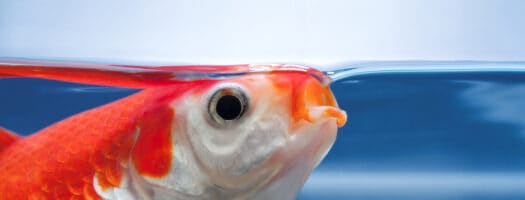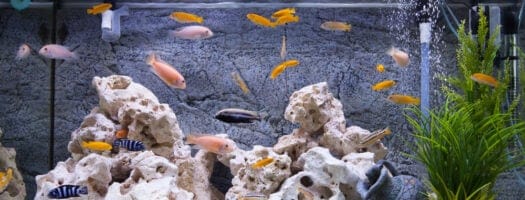The 10 Best Aquarium Lights for Fresh & Saltwater Tanks in 2026
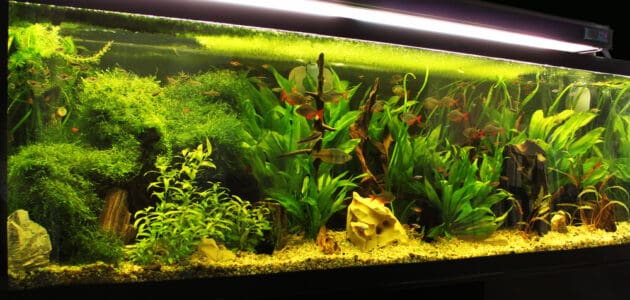
Factors to Consider When Buying Aquarium Lights
Aquarium lighting may be a complicated affair, but it doesn’t always have to be. Before we present you with a list of the best aquarium lights to buy, here are some factors that you should consider first.
Your Aquarium Setup
The first and most important consideration is your aquarium setup. More than anything, this will determine what kind of aquarium lighting you should buy. After all, in order to have a successful aquarium, you should meet at least the bare minimum needed to sustain your aquarium’s flora and fauna.
There are three broad kinds of aquarium setups that will affect your choice for aquarium lighting: decorative, planted saltwater, and planted freshwater tanks. If this is your first time encountering these terms, then jump down to our full buyer’s guide to learn more about tank classifications.
Tank Dimensions
The dimensions of your tank are also something to consider when deciding which aquarium lighting to go with. This is especially true if you have a planted tank since plants can’t thrive without the right amount of light. Is it long but shallow? Then you need to have equally lengthy lighting to reach all areas of your tank. Is it narrow but deep? Then you need lighting with a strong enough intensity that can reach the deepest part of the tank.
If your tank is merely decorative, then you get more leeway in this aspect. That said, even if you’re not raising light-dependent organisms such as plants and corals, you still need enough light to appreciate your aquarium without having to squint, so choose wisely.
Special Features
There are some lighting choices on the market that are specialized for specific aquarium setups. Obviously, these all vary in features depending on what they’re used for. In addition to this, some brands tend to provide more special features than others. Fancier, more expensive LED lighting boasts built-in timers, different colors, color switchers, and other miscellaneous effects.
It’s important to consider which features you want because this ties a lot into the price of the product. It’s best to spend your hard-earned cash only on features that you actually need or want.
Light Specifications
This is a very important consideration if you have a planted aquarium. Remember, in order to photosynthesize properly, plants need a whole spectrum of colors. Without it, they can wither and die. Even if they survive, they won’t be as healthy as they can since they lack something.
As for intensity, too strong or too weak can also negatively affect the growth of your plants. The length, color, and overall appearance of your plants depend highly on the amount of light that they receive. Plus, some plants thrive better in low or bright light, so keep that in mind when choosing your lighting.
Spectrum and intensity will be further discussed below in the full guide, so feel free to jump down if you’d like to learn more.
Appearance
Whether you’re an aquascaping enthusiast or a die-hard predator-fish keeper, you don’t want some gaudy hardware drawing more attention than your prized setup. Your choice of aquarium lighting should blend in with the aesthetics of your tank perfectly.
With that out of the way, now we can proceed to our list of the 10 best aquarium lighting you can buy online right now.
Top 3 Best Aquarium Lights for Planted Freshwater Tanks
1. Best Overall Pick: BeamsWork EA Full Spectrum LED Aquarium Light
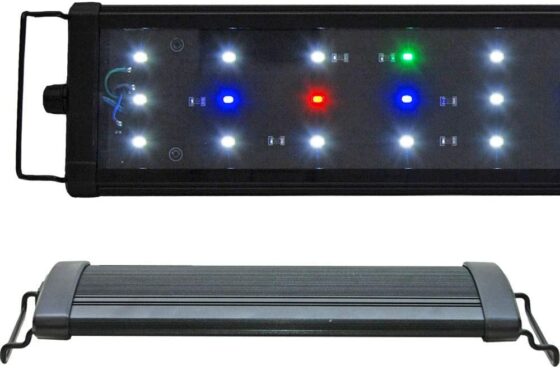
Editor’s Rating:
Why we like it: If you’re looking for bright lights to grow your aquarium plants, make your aquarium colors pop out, and add a dash of excitement to your set-up, then look no further than the BeamsWork EA Full Spectrum.
Quick Facts
- Designed for: Planted freshwater tank
- Type: LED
- Size: 18 in. / 24 in. / 30 in. / 36 in. / 48 in.
BeamsWork’s stunning 10000K light is a great option if your main focus is on growing plants for your underwater world. It has a combination of white, actinic, red, and green LED colors that shine their brightest for optimal freshwater plant growth. It also sports night and daylight mode for each hour of the day.
Overall Performance
The strong and robust full-spectrum illumination of the BeamsWork EA is enough to make most other aquarium lights look dim. The brilliant quality makes the hues of your aquarium pop out at little cost. The LEDs used by this model are energy-saving, long-lasting, low-heat, and are overall way cheaper than most brands. Moreover, the 10000K quality light is more than enough for low-to-medium-light freshwater flora to thrive.
The design is sleek and elegant but not over-the-top flashy so as not to draw attention away from the true star, which is your tank. It has a combination of different sizes and extendable metal brackets that allow you to place the lighting exactly in the middle.
However, as far as customization goes, the BeamsWork EA does not offer any control with light intensity and color combinations. It does allow the use of a pre-set timer, although disappointingly, the timer itself is sold separately for this model.
Pros
- Inexpensive
- Sleek design and built
- Stunning light quality for price
Cons
- Timer is sold separately
- Limited customizability
2. Best Budget Pick: NICREW ClassicLED Aquarium Light
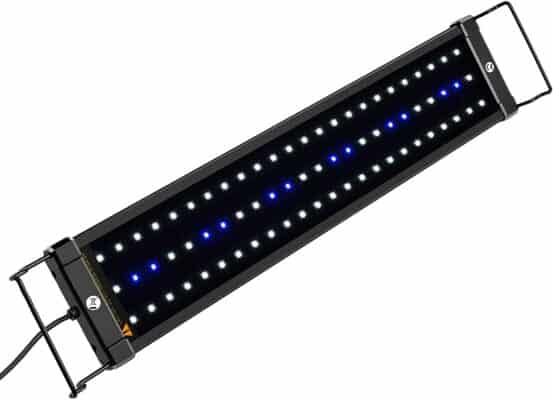
Editor’s Rating:
Why we like it: NICREW’s easy-to-install, user-friendly, price-for-value lighting makes it an absolute blessing for new and experienced aquarium owners alike.
Quick Facts
- Designed for: Non-planted and freshwater
- Type: LED
- Size: 12 – 18 in. / 18 – 24 in. / 30 – 36 in. / 36 – 48 in. / 48 – 54 in.
NICREW’s Classic LED light features an astounding 2,835 pieces of high-output, energy-efficient LEDs that emit a nice 7000K spectrum at only 11w of power usage. It has both nighttime and daytime lighting modes, which means you’ll still have some illumination over your pets without disturbing their rest times. In terms of installation, it has nifty extendable mounting legs that are perfect for long and non-conventional aquarium sizes.
Overall Performance
NICREW’s Classic is wonderfully bright. It can fully illuminate your tank with ease, providing a wonderful contrast between the eye-catching elements of your tan and the different colors of your underwater aquaria. More than that, the intense 7000K spectrum output of NICREW’s LED is great for growing freshwater plants. If you have plants with strict lighting-time requirements, then you don’t have to worry about shrouding your entire tank in darkness, as its blue LED night light mode can provide some illumination with a subdued, mysterious aura.
It’s also very energy-efficient, so you don’t have to worry about exorbitant electricity costs. Lastly, installation is a breeze with its extendable mounting legs that can position your lighting exactly where you want it to, regardless of your tank’s dimensions. The only issue is that the metal brackets can sometimes slide and not hold fast, so be very careful while installing them.
Pros
- Value for price
- High-quality illumination
- Energy-efficient
- Wide, adjustable metal brackets
- Sleek design
Cons
- Poor stability of metal brackets
3. Best Automation: Finnex Planted+ 24/7 Aquarium LED Light
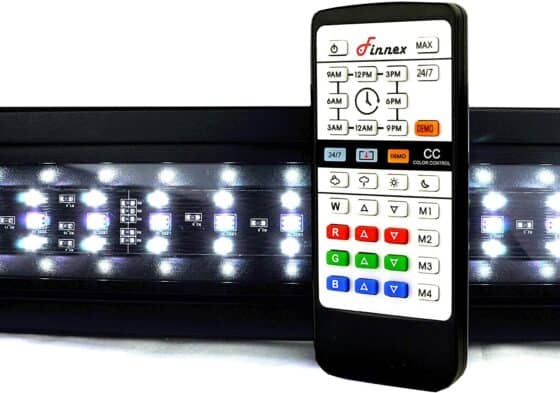
Editor’s Rating:
Why we like it: With its 7000K plant-output, 24/7 biorhythmic-mimicking timer, adjustable sunset and sunrise effects, and four customizable color combination slots, Finnex’s Planted+ is designed for those who want the best outcome with the least effort.
Quick Facts
- Designed for: Planted freshwater
- Type: LED
- Size: 20 in. / 24 in. / 30 in. / 36 in. / 46.5 – 48 in.
The Finnex Planted+ offers a wealth of customization with a convenient hands-free experience. The built-in 24/7 timer simulates the outside world with dawn, morning, noon, dusk, and night light settings. You can also activate weather effects such as sunny days, cloud cover, and thunderstorms with the press of a button. Plus, it has enough memory to remember your last settings and interact with standard timers.
Overall Performance
Finnex wants to strike the perfect balance between convenience and features. It offers a completely hands-free 24/7 timer that mimics the biorhythm of nature outside. It boasts automatic vivid red-orange sunrise and sunsets as well as star-studded night skies and some settings in between. You can play around with weather modes, intensity control and take advantage of 4 memory slots for personal color combinations.
Its 7000K output is perfect for growing freshwater plants, and the light intensity allows for good illumination and color quality of plants and fishes. The lighting can be easily installed, thanks to its legs that can slide inwards to accommodate shorter aquariums. It can also screw-grip for rimless aquariums.
Sadly, despite the relatively high price, the Planted+ only offers limited customizability. For instance, the 24/7 cycle can only be adjusted and not fully customized. The included remote also seems relatively low-quality compared to the rest of the setup.
Pros
- 24/7 biorhythmic timer cycle
- Four memory slots for custom color combinations
- Adjustable light intensity
- Sleek hardware aesthetics
Cons
- Higher price than the competition
- Non-customizable 24/7 cycle
- Relatively low-quality remote control
Top 3 Best Aquarium Lights for Planted Saltwater Tanks
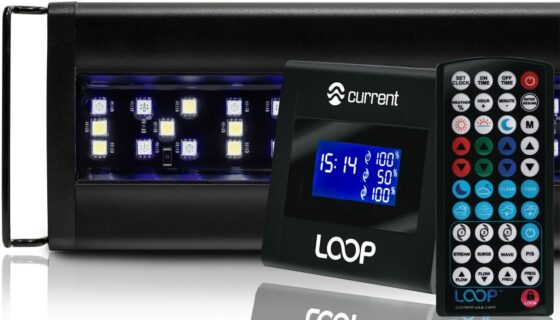
Editor’s Rating:
Why we like it: From mimicking nature’s biorhythms to simulating weather effects, the Current USA Orbit is packed to the brim with wonderful features designed for those who truly want a piece of the deep blue sea in their own home.
Quick Facts
- Designed for: Planted saltwater tank
- Type: LED
- Size: 18 – 24 in. / 24 – 36 in. / 36 – 48 in. / 48 – 60 in.
The Orbit mimics the 24-hour biorhythm of nature outside, simulating sunrise, noon, sunset and evenings – and everything in between. To add to the atmosphere, it also boasts effects such as cloud covers, storms, and even lightning strikes. It comes with fully customizable controls of almost everything in your tank from timers, to light settings, and even wave and pump optimization.
Overall Performance
The Orbit LED is more than just a light– it’s a device that can easily transform your tank from being a mere aquarium to being an underwater, marine paradise, making it the perfect premium pick on our list.
The Orbit boasts bright, dazzling colors in a wide variety of choices that can bring out the color of any fish or plant living in your tank. It even lets you choose and set two of your own color combinations, which you can save for later.
It’s also packed with modes and effects, from morning to night simulations to clear skies, cloud covers, and storms, all accessible via its remote control. Everything is adjustable–the light intensity, lighting times, the 24-hour cycle of your tank, and even the pump and wave controls.
However, the programming and set up of this aquarium light does require time and dedication to figure out. It can be plug and play if you choose not to use its other features, but if you only want the simplest stuff then there are far cheaper and simpler brands that you can buy, like the BeamsWorks EA or the NICREW Classic LED. Certainly, the Orbit is better suited for those who want more for their tank.
Pros
- Built-in 24-hour biorhythm-mimicking timer
- Fully customizable brightness, color, effects
- Remote controlled
- Controllable pump and wave settings
- Extendable brackets
Cons
- Much more expensive compared to other products
- More challenging to set up and program than other lights
2. Best Colors: Viparspectra Full Spectrum Aquarium Light
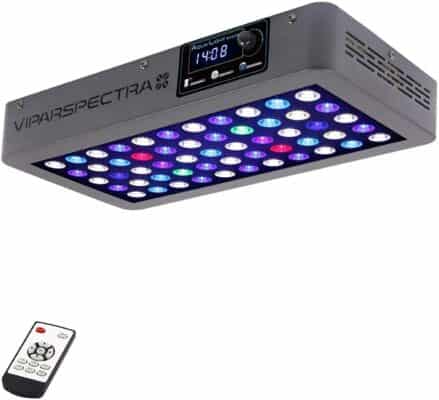
Editor’s Rating:
Why we like it: The Viparspecrta offers you full control of your planted tank’s lighting right in the palm of your hands.
Quick Facts
- Designed for: Planted saltwater tanks
- Type: LED
- Size: 16 in.
The Viparspectra mimics the quality of natural light to keep your underwater inhabitants alive and happy. It has two color spectrums with a built-in timer to control on-off settings for both. You can fully adjust the intensity of lighting from 0%-100%, and it has a separate control for its color channels. The setup is cooled by noiseless fans, and the whole casing is made out of aluminum to dissipate heat better. Best of all, everything is controlled by a nifty remote control.
Overall Performance
The Viparspectra Full Spectrum offers a dazzling array of bright, wonderful colors, all designed to keep your marine corals and fishes happy.
It features two-color channels of blue and white, each designed to cater to the specific needs of both fishes and corals in your reef. More than that, each color system has separate controls, allowing for optimization based solely on the needs of your setup. It has a built-in timer to prevent over or underexposing your beloved reef.
The dimmable intensities and color customization functions can be controlled from one remote. The setup is housed in an aluminum casing for better heat control, and it is further cooled by noiseless fans.
Unfortunately for beginner fishkeepers, setting it up is not as straightforward as others on this list. The other big drawback that we found is the staggering electricity consumption of this product. You can choose between the 165W option or the 300W option, both of which are on the high end of aquarium lighting power consumption.
Pros
- Great lighting quality
- Built-in timer with remote
- Highly customizable
- Sturdy, heat-efficient housing
Cons
- Setup can be a little complicated
- Staggering electricity consumption
3. Best for Coral: Hipargero Nano Reef Aquarium LED Light

Editor’s Rating:
Why we like it: The Hipargero brings out the deep-ocean blue in your nano reef tank with a specialized, professional setup designed to make your corals–and your entire marine ecology–thrive and bloom.
Quick Facts
- Designed for: Planted saltwater tank
- Type: LED
- Size: Suitable for 10 – 18 in. aquariums
The Hipargero LED Light sports three sockets filled with predominantly violet LED lights to bring out the true color of coral reefs and to facilitate their growth. It has two dimmable color channels and an intelligent, silent cooling mechanism that keeps heat in control. It has a touch-control system as well to adjust the lighting intensity and fan controls. The lighting is made from a sturdy metal casing, which is not only durable but also facilitates efficient heat exchange throughout the unit.
Overall Performance
The best aquarium lighting combines excellent features, performance, and price. In this case, the Hipargero LED Nano Reef Light belongs on this list.
As the name suggests, it’s specialized for marine reef environments, specifically the small kind. It has three sockets for high-quality LED light housings. The intense blue LEDs can help corals grow and color more beautifully. It also promotes the growth of beneficial marine bacteria in your tank. The casing is a bold, blocky modern design that is made from sturdy metal to protect the casing and to facilitate efficient heat exchange. The setup is cooled by two noiseless fans.
The biggest and possibly only downside to this product is its high power consumption. That said, if you’re a nano reef owner who wants a compact solution to their coral lighting needs and don’t mind paying more for your electricity bill, then this is a worthy choice.
Pros
- Relatively affordable
- Compact and durable design
- Promotes the growth and beauty of corals
- Specialized for nano reefs
Cons
- High power consumption
Top 4 Best Aquarium Lights for Non-Planted Tanks
1. Best Basic Aquarium Lighting: MarineLand LED Aquarium Light
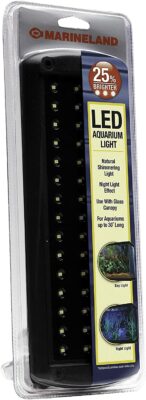
Editor’s Rating:
Why we like it: MarineLand boasts an impressive mimicry of natural sunlight shimmers from its energy-efficient and long-lasting LED lights for a very affordable price.
Quick Facts
- Designed for: Non-planted or planted freshwater tanks
- Type: LED
- Size: 18 – 24 in. and 48 – 60 in.
MarineLand’s product features extremely efficient 60 mW (0.06W) LED lights that reduce energy costs and also last for a long time. Even though it consumes very little power, it’s bright enough to adequately grow freshwater plants throughout all of its life stages and even boasts an underwater shimmer effect. It has extendable brackets for easier mounting and is housed in a subtle but modern casing.
Overall Performance
The MarineLand LED Shimmering Light sports extremely cost-efficient 60 mW (0.06W) LEDs which are also long-lasting and very bright. It provides enough output to let freshwater plants thrive in all of their growing stages and will certainly make your aquarium setup look stunning.
The light itself has night and day modes, which you can toggle with a switch. You can also connect it to an external timer, sold separately, if you want to automate the process. The noon/day setting has a ‘shimmer’ effect that mimics the natural shine that you see underwater.
However, one odd downside to this product is that it’s not waterproof. It’s not even suitable to be placed over open water, as it may damage the product. If you’re planning to use this product, you should put some type of protective covering, like a clear plastic sheet, to act as a barrier between the lights and the water.
Pros
- Special shimmer effect
- Day and night modes
- Sleek, modern housing
- Energy-efficient LEDs
Cons
- Non-customizable
- No built-in timer
- Relatively expensive
- Not waterproof
2. Best Remote Control: Coodia Extendable Aquarium Hood Lighting
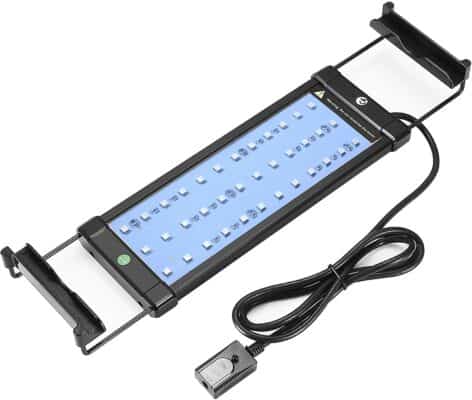
Editor’s Rating:
Why we like it: Coodia’s lighting is for those who want all the essential features but don’t mind sacrificing non-essential ones to save some money.
Quick Facts
- Designed for: Planted freshwater and saltwater tanks
- Type: LED
- Size: 11 – 19 in. / 19 – 28 in. / 28 – 36 in. / 37 – 45 in.
Coodia’s hood lighting offers 7500K lighting suitable for both freshwater and saltwater tanks. It’s powered by a dedicated, energy-efficient power supply that boasts over 10,000 hours of lifespan and its housing can extend to accommodate a large variety of aquarium sizes. It also has 2.4G remotes, bright LEDs, and easy-to-use, long-range remote controls.
Overall Performance
This product is an affordable alternative to larger brands that still retains all the features that we love. It offers 16 different color combinations and a dimmable 7500K light that is more than enough to grow both freshwater and saltwater plants. The high-quality RGB LEDs will also add color to your tank, making it look more vibrant and thriving. It also features flashing and strobing functions for your own entertainment.
The remote control works at quite a long range and broadcasts evenly all around, which means you’re not required to point it at your aquarium for the commands to work. Installation is extremely easy and convenient too. You can simply plug it in and leave it. It has extendable brackets and an aluminum casing for better fitting and heat dissipation.
Do take note that this product doesn’t come with a built-in timer, though. Customizability is also rather limited. If you want something affordable that’s only a little bit better than basic, then Coodia might be one for you.
Pros
- 16 LED color combinations
- Convenient remote control
- Plant-growing light output
- Aluminum casing
Cons
- No custom color-mixing feature
- No built-in timer
3. Best Energy Efficiency: Moonbrook Submersible Led Lights
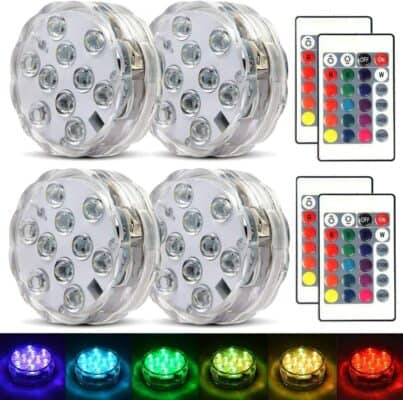
Editor’s Rating:
Why we like it: Moonbrook Submersible LED Lights is a versatile, cost-effective, energy-efficient, and beautiful alternative to expensive, brand name aquarium lighting.
Quick Facts
- Designed for: Non-planted aquariums
- Type: LED
- Size: 2.8 in. x 1.1 in., comes in 4 or 10 pack
These pretty and versatile little lights create a sweet ambiance wherever you choose to put it, be it your garden, your pond, or your favorite aquarium. They’re powered by AAA batteries, which are easily accessible and cheap to boot. You can choose to mix and match 16 different colors, as well as four dynamic modes of color changes. It also has enough memory to remember your last settings.
Overall Performance
The Moonbrook Submersible LED lights have 16 different colors and four color modes, so you can bring out any color of any aquatic critter that you might have in your setup. You can adjust the brightness and color combination through a remote with a 30 feet radius.
These lights have overheating protection as well as a waterproof rating of IP68. Plus, unlike brand-name aquarium lights, they’re operated by triple-A batteries, which are very cheap and easy to replace.
Sure, you won’t be growing any plants or corals with this lighting – but as a tradeoff, your fishes are going to look really pretty with the various light settings that you can choose. Do keep in mind that there’s no timer available, though, so you have to manually turn it on and off every time.
Pros
- Very cheap compared to brand name products
- Great lighting control
- Good quality illumination
- Operated by AAA batteries
- Remote control included
Cons
- Not specialized for aquariums
- No timer included
4. Best Clip-on Aquarium Light: Aqueon Clip-on Aquarium LED Light
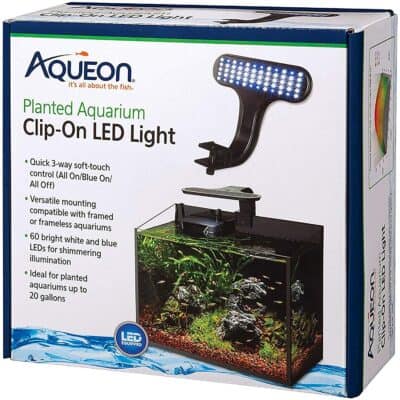
Editor’s Rating:
Why we like it: The Aqueon Aquarium Light doesn’t come with all the ribbons and decorations that other brands do, but it does come with much-needed reliability and durability.
Quick Facts
- Designed for: Non-planted and planted freshwater tanks
- Type: LED
- Size: N/A
The Aqueon Clip-On Light sports 60 pieces of LEDs that support the growth of your plants in setups up to 20 gallons in volume, with two different blue and white color channels. Most interestingly, it sports an incredibly convenient clip-on installation that works in both framed or frameless aquariums. From the super easy, almost-universal clip-on application to the robust and durable casing, the Aqueon is something any tank keeper can rely on.
Overall Performance
The Aqueon is thin and elegant, with bright and efficient LEDs that are perfect for any freshwater plant. It has soft-touch control features that toggle between three modes: on-all, on-blue, and all-off. You can hook this up with a timer to make the best use of these simple features, although you may have a hard time finding a compatible timer for it.
It has clip-on features that render dimension requirements useless, just clamp and screw it to the top edge of your tank, regardless if it is rimmed or not. It can be slightly flimsy though, so make sure that you secure it first. The casing is robust, the overall quality is rather decent, and it provides good value for the price that it asks for.
If you want plain and simple quality without all the bells and whistles, then the Aqueon is just the one for you.
Pros
- Clip-on attachment
- Day and night color modes
Cons
- Incompatibility with standard light timers
- Clip-on mechanism is rather flimsy
Ultimate Guide to Aquarium Lights
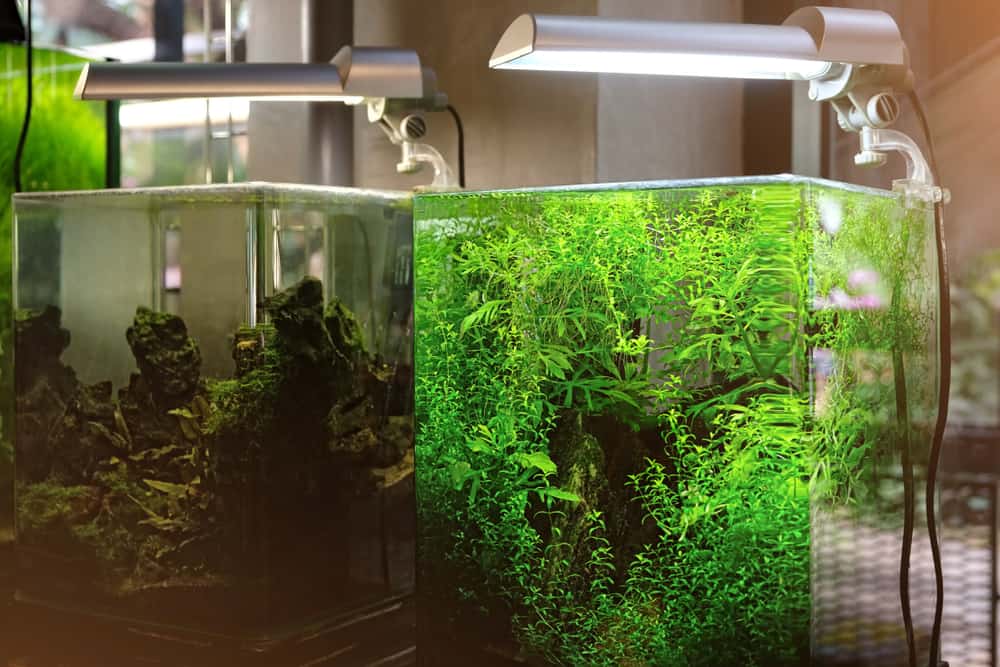
If you’re serious about fishkeeping, your aquarium lighting is one of the most important parts of your setup. After all, lighting is a must, even if you don’t keep any aquarium plants or corals. Simply being able to see your pets in a better light is a good enough reason.
However, lighting is a complex topic that is bound to confuse most beginner aquarium owners. Serious hobbyists spend a lot of time discovering and developing formulas, builds, and fixes to further improve their aquarium lighting, but there’s still no one solid way that is applicable for everyone.
This guide is here as a comprehensive, exhaustive summary of all the important information that you will need if you’re setting up your aquarium lighting from scratch.
What Is Aquarium Lighting?
Aquarium lighting refers to the part of your setup that produces visible light for your aquarium and all its inhabitants. Not only is lighting important if you want to see your aquarium in all its glory, but it also acts as a mini sun for your little aquatic world. This means that your aquarium inhabitants rely on your lighting to determine the time of day and what activities they should be doing. Plants and corals also rely on light for photosynthesis, growth, and even reproduction.
Aquarium lighting comes in many different forms. It can vary wildly from DIY installations to hundred-dollar setups that are specialized to mimic one specific environment. In this article, we will discuss everything there is to know about aquarium lighting, its benefits, features, and how to determine the best lighting for your needs.
Benefits of Using Aquarium Lights
- See the conditions of your aquarium more clearly
- Clearly displays the colors present in your aquarium, enhancing the visual appeal
- Allows plants and corals to photosynthesize for their growth and reproduction
- Soothes your animals as it mimics the rhythms in nature
Important Features of Aquarium Lighting
All tanks vary depending on their needs. However, to help you determine what is best for you specifically, we need to consider the most crucial features of your lighting fixture.
Color Spectrum
Have you ever noticed how some lights, even those with the same color, can vary in temperature? This color temperature is measured in Kelvin (K). It typically varies from the warm and yellowish 2700K to the cool and bluish light of 6500K, although this number can go as high as 10000K.
Plants can thrive on a variety of color temperatures, but the most common range hobbyists like to be at when considering aquarium lighting is between 6500K to 7000K, as it best simulates natural daylight. If the light is strong enough, any Kelvin rating will do to raise fishes and plants.
However, if you’re raising saltwater corals, you’re going to have to stay at a certain color spectrum. Corals need blue light to thrive, so you should pick something with a Kelvin rating that corresponds to this color.
Light Intensity
Light intensity refers to how bright your lighting is. It’s also one of the most important determinants of plant growth.
There are certain plants that are only happy with specific light intensities. These are categorized into low light, medium light, or high light plants, which are somewhat self-explanatory. However, it’s important to note that although aquarium plants are typically fitted into these categories, it doesn’t always mean that this is set in stone. For example, some medium light plants can survive even in low light conditions, only they won’t grow as fast or vibrant.
Another thing to remember about light intensity is the PAR rating, which stands for Photosynthetically Active Radiation. The PAR rating is measured using a PAR scale, and it depends greatly on your tank’s depth. Basically, the greater your tank’s depth, the more intense your lighting should be for the light to reach the bottom. More information about the PAR will be discussed below.
Light Spread
It’s also important to consider how far light spreads. Since most aquarium lighting is designed to deliver high intensity light, it usually has at least a 1-foot light spread below. Outside of this number, plants won’t get as much lighting anymore. In contrast, shop lights and house lights were manufactured to have a wider spread because they’re designed to light up entire rooms.
Types of Aquarium Setups
The type of setup you have will affect the kind of lighting that you need for a thriving tank. Obviously, planted tanks are much more demanding when it comes to light. Tropical plants and saltwater corals require specific color spectrums, intensity, and brightness to function.
Other than that, you’d typically want something that complements your existing setup. For example, many owners with non-planted tanks tend to go for lights that will complement the color of their fish or their decors instead.
For Decorative/Non-Planted Tanks
If you’re not raising any plants or corals in your aquarium, you have much more leeway regarding your lighting considerations. Although fishes also live better with optimal lighting, they don’t actually need anything sophisticated to survive.
That’s why, when it comes to decorative or non-planted tanks, you only need to think about what you want your tank to look like. This could mean choosing red-colored lighting if you want a warmer vibe, or a blue-colored one for a cooler tone.
Planted Freshwater Aquariums
If you’re going to raise aquatic plants in your tank, then you’re going to need lighting with the proper temperature and intensity to allow them to photosynthesize. With this in mind, you should carefully consider the amount of lighting that you have in your tank.
Too much lighting will lead to algae blooms and may even kill your plants. Too little light and they will wilt due to lack of food. For planted freshwater plants or floating plants, a Kelvin scale of 6500K-7000K best mimics the sun’s natural light.
Planted Marine Aquariums
Saltwater aquariums have much stricter considerations when it comes to lighting, as corals need a specific spectrum of light to grow and thrive. Corals need blue to violet light to successfully thrive in your aquarium, which corresponds to a Kelvin scale of 15,000K-20,000K.
Determining the Amount of Lighting for Your Planted Setup
As mentioned above, planted tanks have more requirements than non-planted tanks. There is no universal way of telling the magic number of lighting that you need to have for your aquarium plants to thrive, save for a couple of helpful guidelines. However, these guidelines aren’t perfect, so for best results, consider using a combination of rules to determine the amount of lighting you need in your tank.
Lumens per Liter
Plants and corals in your aquarium often require a minimum of 10 lumens per liter to survive. For high light plants, at least 40 lumens per liter is necessary. Medium-light plants fall in the middle of those two ranges.
Sadly, you can’t depend on this rating alone, as it also varies depending on your tank’s dimensions. As light travels deeper into the water, it grows weaker due to dispersion. This means that if you have a deep tank, you need to consider more than just the lumens outright stated on the packaging.
PAR Meter
Photosynthetic Active Radiation (PAR) is the amount of light that is available in a space that plants can use to make food. This has more to do with how your light interacts with space within your aquarium, so most products don’t mention the PAR ratings in them. If you want to know the rating, you can measure PAR with a special meter – bought separately, of course.
However, this still isn’t the perfect scale, as plants absorb some wavelengths of light much better than others. Plus, the PAR scale does not distinguish between wavelengths, just how much light there is.
Watts per Gallon
Admittedly, the WPG scale is no longer as helpful now since it was formulated before the era of high powered, energy-efficient LED lights. There’s simply no use comparing the amount of light that a watt of LED can produce versus a watt of fluorescent or compact fluorescent light, as the former will always produce more light at lower wattages.
That said, many fishkeepers still consider this scale due to its straightforwardness and simplicity. Besides, if you choose to use non-LED lights, this scale will be very helpful to you.
Kinds of Aquarium Lights
There are many different kinds of aquarium lights manufactured in the market. This section will discuss the most common ones and what they can offer to your tank.
LED Lights
LED, or Light Emitting Diode, is the most common aquarium lighting available on the market today, as it can deliver intense lights for much smaller energy costs than other kinds of light, like fluorescent lights.
Another reason for their popularity is their customizability. Some LED lighting can be set to have different colors, modes, and effects, as well as adjustable dimness and color intensity. More than that, LEDs last long, do not have any toxic chemicals in them, and do not emit excessive heat. It’s important to note that their prices tend to vary wildly though, due to high demand.
Normal Fluorescent Lights
You can use the same kind of fluorescent lights you use at home in your aquarium. Compared to other kinds of lighting, these lights are relatively cheap and are much more energy efficient compared to incandescent bulbs. The downside is that they don’t have the same output-per-wattage and longevity as LED lights. Still, many planted tank keepers prefer fluorescent lighting for their reef setups, if only to keep the tradition going.
Compact Fluorescent Lights
Compact Fluorescent (CFs) lights are the more modern cousins of fluorescent lighting. As the name suggests, they are compact and offer more output per wattage than fluorescents. They also emit lower heat and are very easy to operate. Due to this, they are very effective for nanosystems. You can rig your own DIY CF lighting systems, but keep in mind that different brands have different light-to-hood compatibility.
Metal Halide Lighting
Metal Halide lights emit high intensity, high heat, and high brightness output which are suitable for sprawling, high-maintenance setups that have equally huge light demands. These lights produce a lot of heat and consume a lot of energy, but in return, you get that extra-bright light needed for deep–at least 24 inches–planted tanks, typically the saltwater variety. That said, keep in mind that metal halide lights emit radiation. Some brands even require the use of UV shields to lower the radiation levels of these lights.
How to Install Aquarium Lights
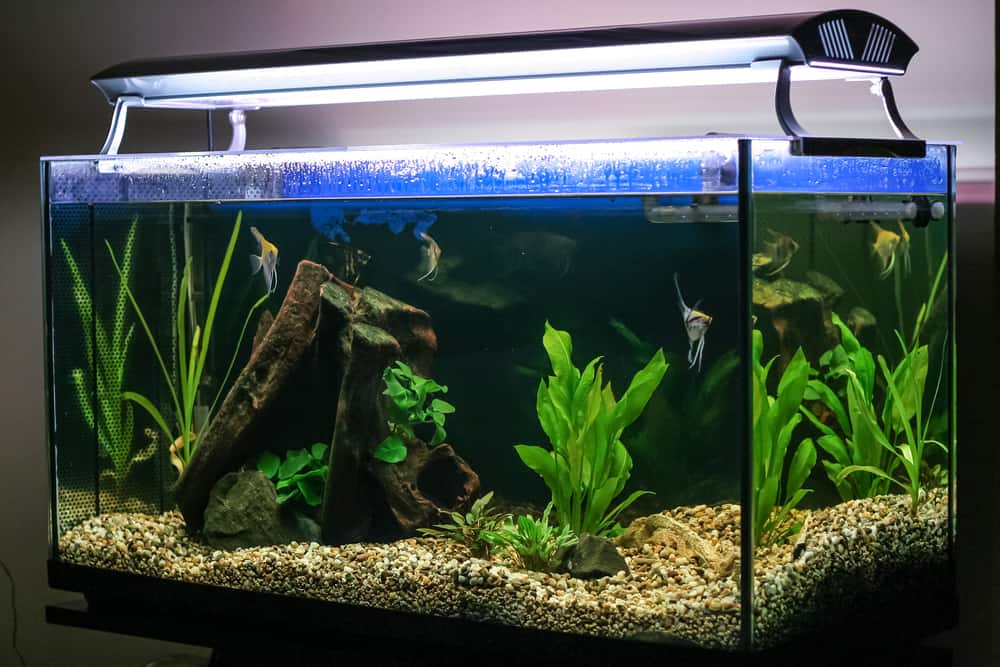
Installing your aquarium light is going to vary a lot depending on your product, however, there are general steps that you can follow to properly mount your prized purchase.
- First, unpack your aquarium lighting carefully from its box
- Make accurate measurements of where your light is supposed to go. This includes centering, and if installing hanging lights, how high up they dangle from the surface of the water.
- Assemble your product so that it’s ready to mount. If you’re buying lights with extendable legs, extend or retract them to the proper height.
- Mount your light to the aquarium. Ideally, you should place it on top and at the center so that it covers the whole area of your tank. If you have clip-on lights, make sure that the clamp is fastened tight to the rim of your aquarium.
- Plug-in your light.
- If your setup requires some sort of programming and timing, this is the part where you should do so. Make sure that you remember all the functions, preferences, and commands of the remote control.
For DIY or eccentric setups, simply follow the manufacturer’s guide for the proper installation.
Tips for Buying Aquarium Lights
- Before you purchase lights for your aquarium, take note of its mounting options and find out whether or not this is applicable for your tank. Figure out how far the legs could go, or whether or not it can clip on to rimmed or rimless tanks, and even whether or not it unifies with the aesthetics of your design. Good light is useless if you can’t mount it to your aquarium.
- Find out how high or wide your mounting space could be. Your hundred-dollar light is next to useless if you can’t fit it into the space where your aquarium is.
- Take note of the specific plants and animals in your tank. Make sure to fulfill above-minimum requirements for their growth for best results. This will help you narrow down your choices of products.
FAQs
1. Could My Light Be the Cause of My Aquarium Plants Dying?
Certainly, lighting plays a large and important role in the survival and growth of your aquarium plants, and it should be one of your main considerations when buying and planting them. However, that’s not all there is to raising plants. There are other factors such as water quality, CO2 levels, and even parasites and disease that can kill your plants just as well.
2. How Are My Freshwater Plants Affected by the Color of My Lights?
Plants can thrive under different color spectrums, but having single-colored, RGB lighting is not the best idea for aquariums. This is because although some plants might survive in one light alone, some plants won’t. As such, it’s always best to have different combinations of colors when raising freshwater aquarium plants.
For best plant growth, it’s advised to use between 6500K to 7000K light quality, as it best mimics sunlight.
3. How Long Should My Aquarium Lights Be Turned On?
Ideally, your aquarium should mimic the natural environment where your underwater inhabitants can thrive–and not just for plants alone. Even if you have non-planted tank, a period of darkness allows your fishes to rest and recuperate after a long day of swimming around.
If you do have a planted tank though, then you have all the more reason to schedule your lights’ on and off times. Plants and corals require both a minimum and maximum photoperiod, also known as the time that they can bask in light to create their food. Too short and the plants will be stunted in their growth. Too long and algae may develop.
As we’ve discussed above, algae can negatively harm your aquarium and cause both plants and animals to die.
These photoperiods differ from plant to plant and are generally much more subjective than you would think. However, for a general guideline, aim for at least 6 to 8 hours of lighting per 24 hour period.
Final Thoughts
As you can see, there are a lot of things that you have to consider if you want a happy, thriving, beautifully lit aquarium. However, with all the information in this guide, you should be well on your way to creating a stunning aquascape with the proper lighting. If you want to make sure your fish stay warm and healthy, make sure to read our article on the best aquarium heaters to buy.
